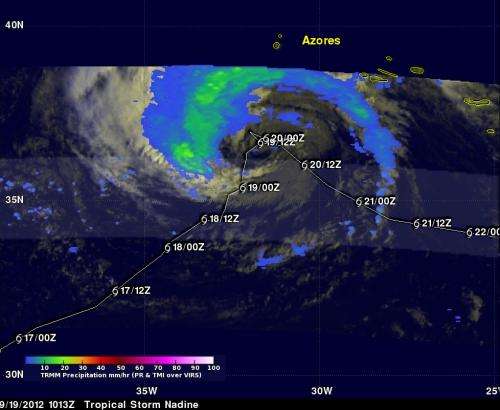NASA satellite sees fading rainfall in Tropical Storm Nadine

Tropical Storm Nadine continues to bring rains and winds to the Azores in the eastern Atlantic Ocean, but that rainfall continues to diminish according to data from NASA satellites. NASA's unmanned Global Hawk aircraft is also exploring the storm today, Sept. 19.
A tropical storm warning is in effect on Sept. 19 for the islands of Flores, Corvo, Faial, Pico, Sao Jorge, Graciosa, Terceira, Sao Miguel and Santa Maria in the Azores.
The Tropical Rainfall Measuring Mission (TRMM) satellite flew over Nadine on Sept. 19 at 1013 UTC (6:13 a.m. EDT) and captured data on rainfall rates occurring within the tropical storm. TRMM's Microwave Imager (TMI) and Precipitation Radar (PR) data showed that no rainfall was occurring near Nadine's center. The maximum precipitation intensity found in rain bands around Nadine was only about 0.8 inches (20mm) per hour. The lack of convection (rising air that forms the thunderstorms that make up the tropical cyclone) is a sign that the tropical storm is decaying or weakening.
NASA's Hurricane Severe Storms Sentinel (HS3) Mission plans to send one of the unmanned Global Hawk aircraft to investigate Nadine again on Wednesday, Sept. 19.
On Sept. 19 at 11 a.m. EDT Tropical Storm Nadine's maximum sustained winds were near 50 mph (85 kmh). Nadine was located about 270 miles (430 km) west of the Azores islands, near 37.2 north latitude and 31.8 west longitude. Nadine is moving toward the north-northeast near 5 mph (7 kmh) and is expected to start drifting to the east-southeast. Nadine's estimated minimum central pressure was 993 millibars.
According to the National Hurricane Center, early on Sept. 19, Corvo in the Azores reported sustained winds of 42 mph (68 kmh) with a gust to 58 mph (93 kmh). In addition, ocean swells continue to affect the Azores and are causing life-threatening surf conditions and rip tides.
The National Hurricane Center noted that if Nadine continues to show weaker convection, it may no longer qualify as a tropical or subtropical cyclone.
Provided by NASA's Goddard Space Flight Center





















